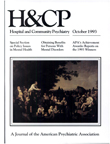Borderline Personality Disorder and Impulsive Sexual Behavior
Abstract
Patients with borderline personality disorder provide an ideal sample for a study of impulsive sexual behavior and factors related to it in psychiatrically ill women. Even though impulsive sexual behavior is one of the DSM-III-R criteria for borderline personality disorder, not all patients with the disorder manifest such behavior. While controlling for diagnosis, we identified factors related to sexual impulsivity of these patients.
Our results suggest that impulsive sexual behavior is common in some women with borderline personality disorder. Forty-six percent of the women in our sample reported that they had impulsively entered into sexual relationships with partners they did not know well. Al though many axis I conditions that could contribute to impaired judgment were present, only alcohol abuse correlated with sexual impulsivity. Patients with impulsive sexual behavior were more likely to receive a comorbid axis II diagnosis of histrionic personality disorder, were more likely to have general problems with impulsivity, were more extraverted, and suffered less from anxiety. They appeared to be very different from another group women with borderline personality disorder who complained of severe anxiety and chronic emptiness and boredom and who were likely to exhibit symptoms of anorexia and selfmutilation.
For the practicing clinician, one implication of these findings is that exposure to HIV through sexual contact may be a pressing concern with only some patients with borderline personality disorder. Our findings suggest that practitioners should be especially concerned with more extraverted, histrionic patients who experience low levels of anxiety and who abuse alcohol. Other patients with borderline personality disorder who are more anxious and who have symptoms of anorexia and self-mutilation may be at lower risk for infection.
One limitation of this study is the difficulty of reliably assessing what is essentially private and unobserved behavior. Subjects are likely to deny behaviors, including sexual practices, that they feel are socially unacceptable. Future research should investigate whether the impulsive sexual behavior these patients exhibit is also unsafe sexual behavior that is likely to put them at risk for HIV infection. Also of importance will be studies of HIV seroprevalence among patients with borderline personality disorder, although as Coyle and associates (10) have pointed out, rates of seropositivity do not accurately measure risk behavior.
Access content
To read the fulltext, please use one of the options below to sign in or purchase access.- Personal login
- Institutional Login
- Sign in via OpenAthens
- Register for access
-
Please login/register if you wish to pair your device and check access availability.
Not a subscriber?
PsychiatryOnline subscription options offer access to the DSM-5 library, books, journals, CME, and patient resources. This all-in-one virtual library provides psychiatrists and mental health professionals with key resources for diagnosis, treatment, research, and professional development.
Need more help? PsychiatryOnline Customer Service may be reached by emailing [email protected] or by calling 800-368-5777 (in the U.S.) or 703-907-7322 (outside the U.S.).



